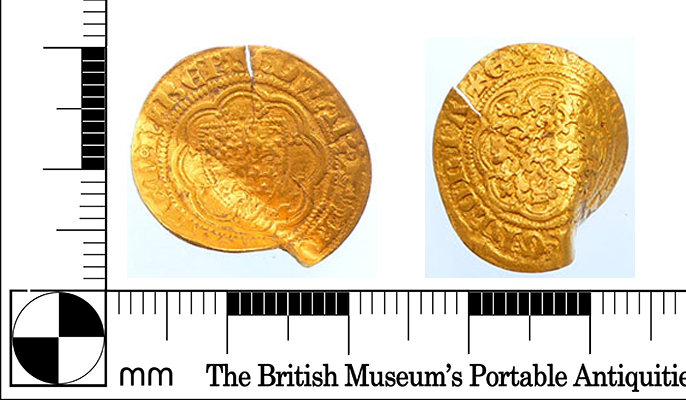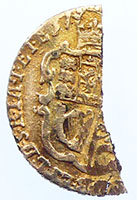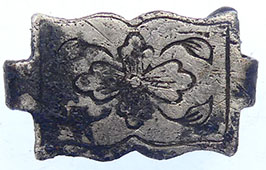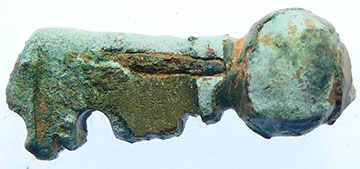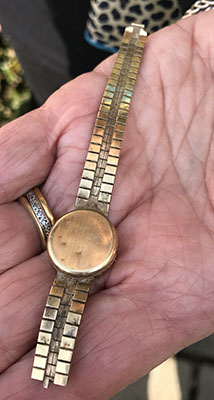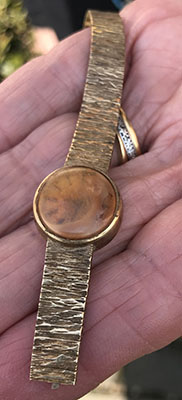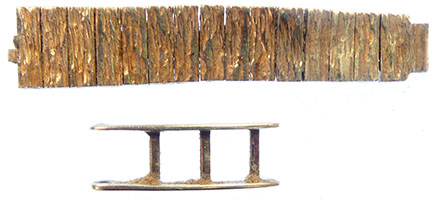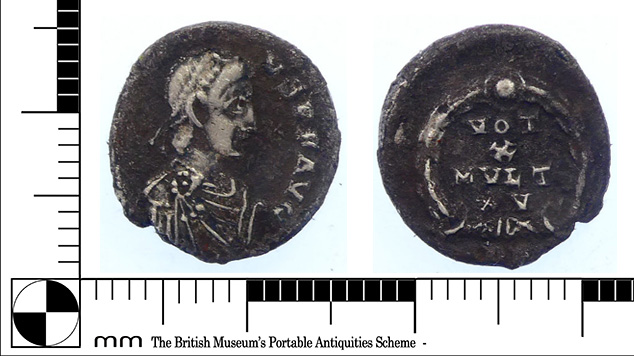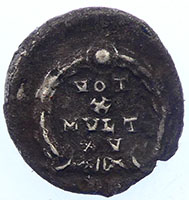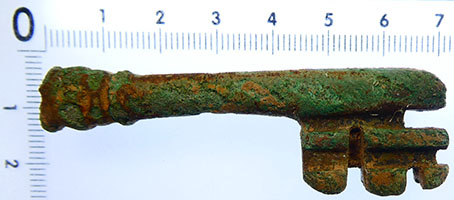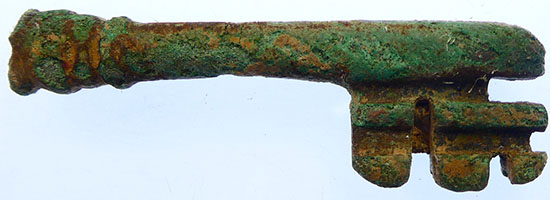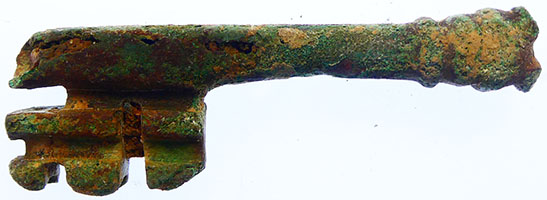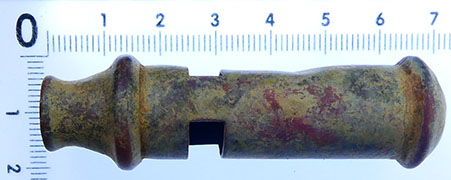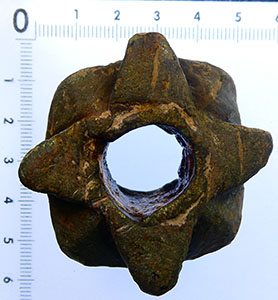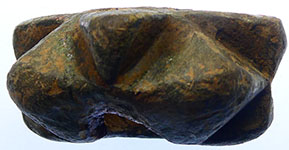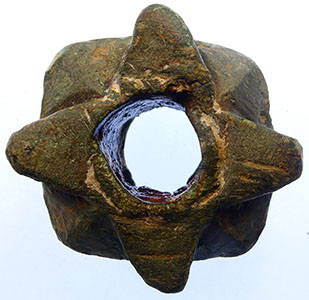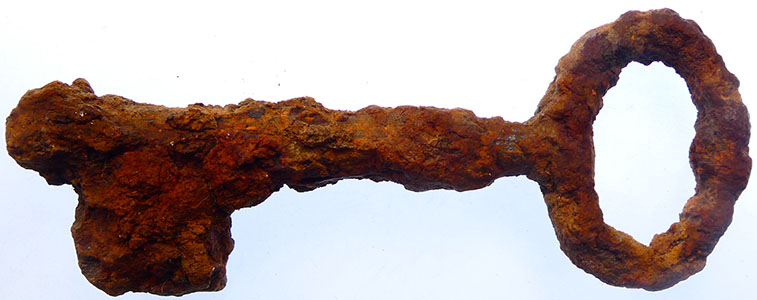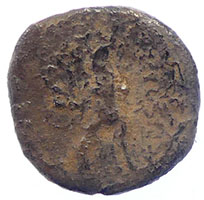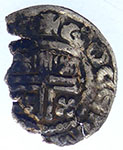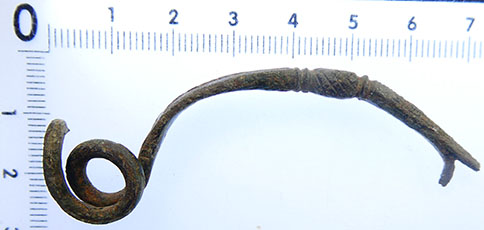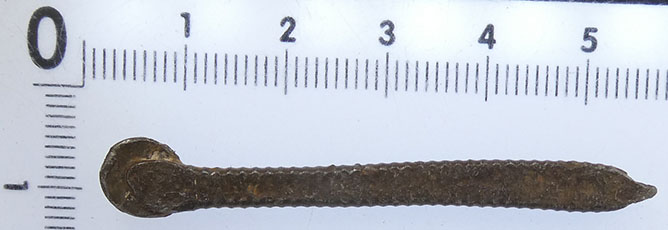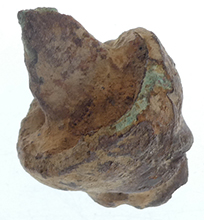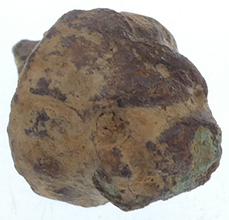

Metal detecting holidays in England with the World's most successful metal detecting club.20 years plus.
Twinned with Midwest Historical Research Society USA.
2023 April finds page |
Ill Tom and Fl Dan with their freebie club sweatshirts for their beauty gold finds
1.81g, 20.1mm
Picture from the field This coin is a mule with two dies series B&E
Edward III (1351-61), Quarter-Noble, 1, fourth coinage, Pre-Treaty period, series B/E mule, mm. cross 1, edwar r[ ] angl z franc d hyber, royal arms on shield, pellet below, rev. + exaltabitvr in ghloria, annulet stops, floriate cross,, trefoil and lion in each angle, eight-arc double tressure Mint mark Cross 1 Obv +EDWAR o R oANGL Z FRANC o D o hYB ER |
|||||||
  |
 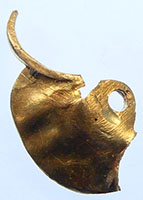 |
||||||
| 1817 George III milled silver sixpence | 19thC gold tooth plate 0.6g, 19.1 mm |
||||||
18thC George III milled gold qtr guinea 0.79g, 15.1mm |
|||||||
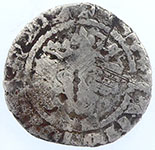 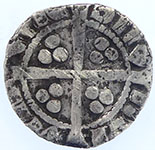 |
 |
 |
|||||
1279 Edward 1st hammered silver penny Obv + EDWR ANGL DNS hYB Rev VILL/SIIIE/DMV/NDI- Bury St Edmunds mint
|
19th livery button | Corporation button 'Merry Christmas' |
|||||
 |
 |
 |
|||||
| 16thC Tudor button | Unknown militia - BN ? | Unknown militia - Prince of Wales feather with V under | |||||
  |
 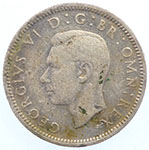 |
||||||
| 1940 George V milled silver sixpence | 1940 George V milled silver sixpence | ||||||
11.03g, 54.16mm L
6.17g, 28.3mm L Interesting chunks of gold or brass ? Gold testing kit does not show 22,18, or 9 carat gold. However it reacts for base gold with high zinc content - White vinegar does not react as it should do on brass. Taking it to the museum for their views.
|
|||||||
  |
  |
||||||
1189- Richard 1st hammered silver short cross penny - Class 4 Obv hENRIC REX Rev STIVENE.ON.LVND - Moneyer Stivene of London mint |
Taco'd 1247 Henry III hammered silver voided long cross penny | ||||||
 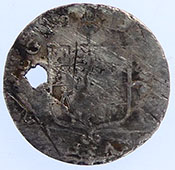 |
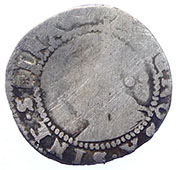  |
||||||
One of the earliest milled coins during the hammered silver coin period. Nicholas Briot's coinage 1631-9 Charles 1st milled silver half groat |
1584-6 Elizabeth 1st hammered silver half groat - Escallop mint mark | ||||||
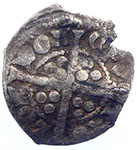  |
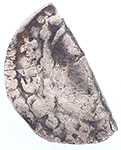  |
||||||
1300-10 Edward II hammered silver farthing- new issue with inner circles both sides - oval flan - Type 28f Obv +EDWARDVS REX AN Rev CIVI/TAS/LON/DON - London mint mark |
Taco'd Pre 1216 hammered silver short cross penny | ||||||
 |
 |
 |
|||||
Silver band Birmingham mint date letter O 'Troup Cup 1913' Maker JF- James Fenton 1854..1904 |
1908 WWII Essex Yeomanry cap badge King Crown |
WWII Royal Engineers button | |||||
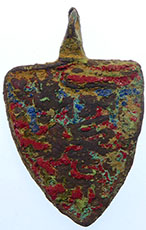  |
 |
||||||
| Medieval heraldic harness pendant | 18thC crotal bells | ||||||
Iron Age Terret Ring 1st Century BC – 1st Century AD The terret is a metal loop found on a horse harness, guiding the reins and preventing them from becoming tangled on the harness. |
|||||||
  |
 |
||||||
| Post medieval lead cloth seal | 1540 to 1700 monogrammed mount | ||||||
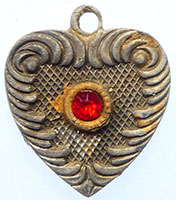  |
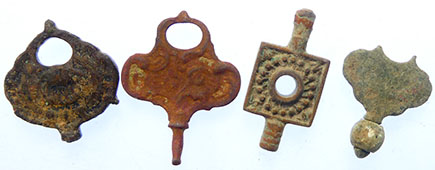 |
||||||
| 20thC pendant | georgian watch winders | ||||||
 |
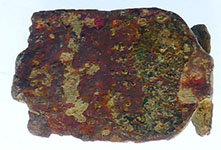 |
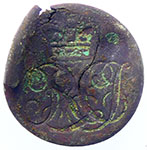 |
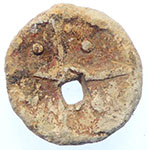 |
||||
| French Infantry Button 60th Line Regiment Circa 1803-1814 |
18thC clog fastener | Victorian Army button RCI which is Royal Chelsea Infirmary.
|
15th C lead token | ||||
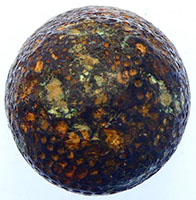 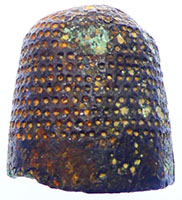 |
 |
||||||
| Medieval thimble | Georgian key | ||||||
 |
 |
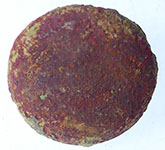 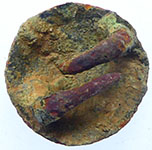 |
|||||
| 19thC Customs button | 17th sword belt fitting | 1500-1700 mount | |||||
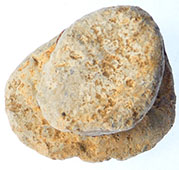 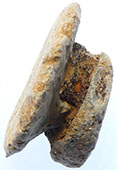 |
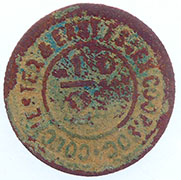 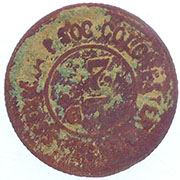 |
||||||
| Medieval bronze lead pot mend | 19thC Colchester & East Essex Co-operative half penny token | ||||||
Georgian pill box |
|||||||
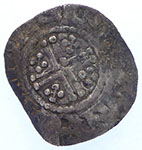 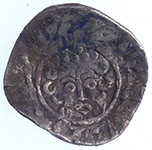 |
 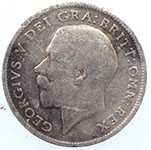 |
||||||
| 1216 Henry III hammered silver voided short cross penny | 1918 George V milled silver sixpence | ||||||
 |
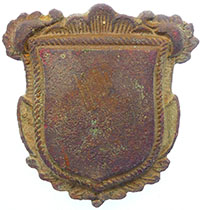 |
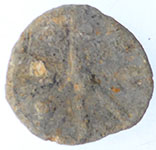 |
 |
||||
| 1600-1700 buckle | Victorian mount | 15thC lead token | 19thC cooper half penny over stamped SHERMAN | ||||
1761-1780 18thC decorated silver clog fastener Hester Bateman First recorded English woman silversmith London Assay office
|
|||||||
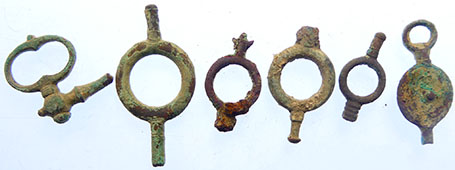 |
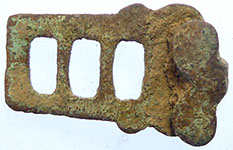 |
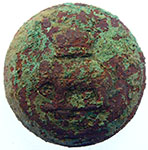 |
|||||
| Georgian watch winders | 18thC clog fastener | The 1st Punjab Regiment ? | |||||
 |
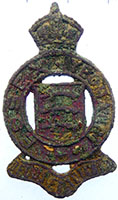 |
 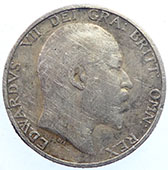 |
|||||
| Georgian button | 1908 WWII Essex Yeomanry cap badge King's Crown |
1909 Edward VII milled silver shilling | |||||
 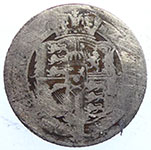 |
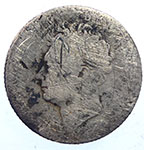 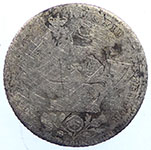 |
||||||
| 1818 George III milled silver sixpence | 1820-30 George IV milled silver sixpence | ||||||
  |
 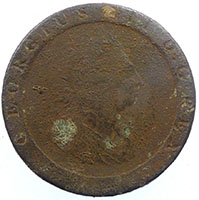 |
||||||
| 1910 - 1935 George V silver jubilee medallion- Issue by the Teddy Tail league for the Daily Mail newspaper | Great shape 1797 George III cartwheel penny | ||||||
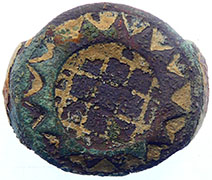 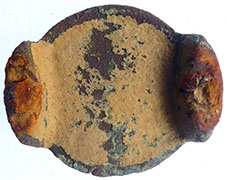 |
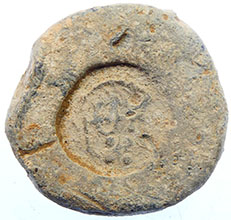 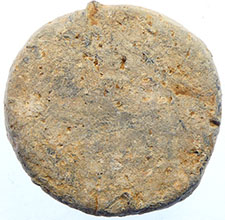 |
||||||
| 17thC belt slide | Post medieval lead trade weight | ||||||
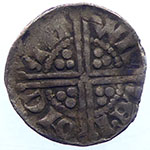 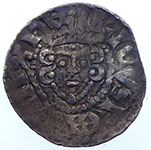 |
|
||||||
1247 Henry III hammered silver voided long cross penny Obv hENRICVS REX III Rev WIL/LEM /ONC/AN - Willem of Canterbury mint |
Tiny Roman bronze key ? | ||||||
 |
 |
 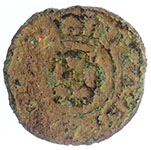 |
|||||
| Georgian buttons | WWII Royal Artillery button | 1634 Charles 1st hammered copper rose farthing | |||||
 |
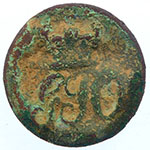 |
 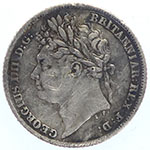 |
|||||
| 18thC Royal Navy silver button | Victorian General Post Office button | 1823 George IV milled silver sixpence | |||||
 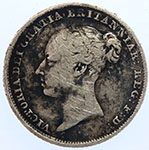 |
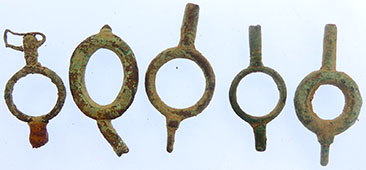 |
||||||
| 1840 Victoria milled silver sixpence | Georgian watch winders | ||||||
 |
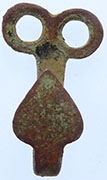 |
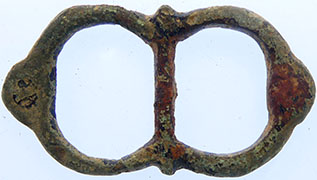 |
|||||
| Roman mount | Georgian spur fitting | 1500-1650 buckle | |||||
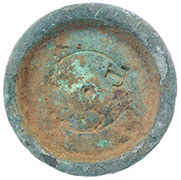 |
 |
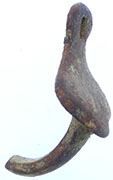 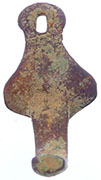 |
|||||
| Georgian trade weight | Georgian buckle | Georgian hook | |||||
 |
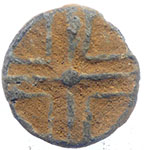 |
 |
|||||
| Georgian button | 15thC lead token | 18thC crotal bells | |||||
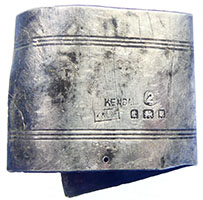 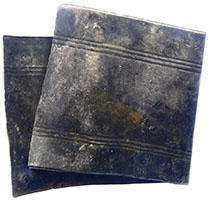 |
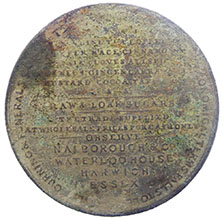  |
||||||
1934 Silver cane band - London mint Maker - Kendall & Sons Ltd - Stick mount, umbrella - 1923..1940 Umbrella maker, Charles Street, Leicester; Bull Street, Birmingham; Holborn Bars, London EC1 |
19th C Advertising token Naiborough & Co, Waterloo Hse, Harwich Haberdashers
|
||||||
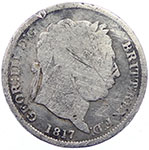 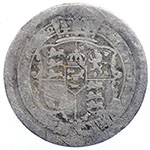 |
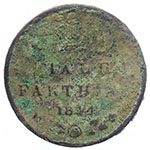 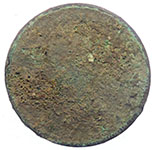 |
||||||
| 1817 George III hammered silver sixpence | 1844 Victoria copper half farthing | ||||||
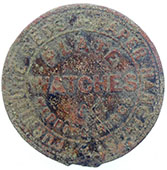  |
 |
 |
|||||
| 1880-1890 John Robert Bedwell token Colchster Essex Obverse Legend on five lines, the top and bottom curved. Lettering: COLCHESTER J. R. BEDWELL 62 & 63 HIGH STREET Reverse Legend on five lines, the top three and bottom one curved. Lettering: FURNITURE BEDS AND PAPER HANGINGS * PLATE WATCHES & |
1500-1700 mount | Victorian Metro Police Force button | |||||
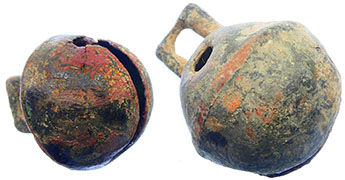 |
 |
||||||
| 18thC crotal bells | Medieval to Georgian thimbles | ||||||
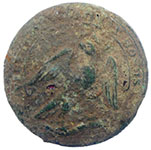 |
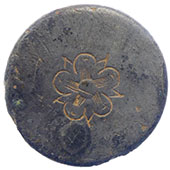 |
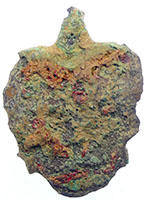 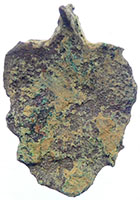 |
|||||
| 19thC livery button | 18thC Royal Navy button | Medieval heraldic shield pendant | |||||
|
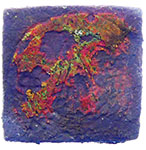 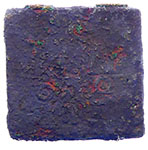 |
||||||
| Victorian whistle | 1351-1412 British Ryal - King with sword and shield standing in a ship type coin weight | ||||||
 |
  |
||||||
| Georgian cherub mount | 1723 George milled silver shilling - love token | ||||||
Rachel lost the solid gold watch on her land 50 years ago and it was a present from her Auntie. Nj Joe while searching her sheep pasture found it and then presented it back to her.
|
|||||||
 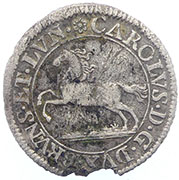 |
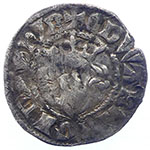  |
||||||
1762 Karl 1st -- 1/12 Thaler
* CAROLVS.D.G.DVX.BRVNS.ET.LVN: NACH.DEM.LEIPZIGER.FVES.1762 |
1279 Edward 1st hammered silver penny Obv +EDWAR ANGL DNS hYB Rev CIVI/TAS/CAN/TOR - Canterbury mint |
||||||
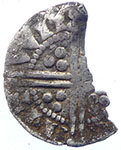 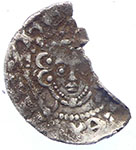 |
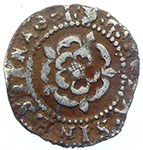 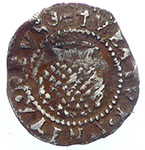 |
||||||
| 1247 Henry III hammered silver voided long cross penny | 1603 James 1st hammered silver penny | ||||||
  |
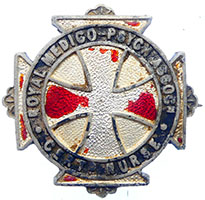 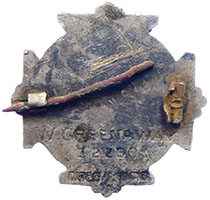 |
||||||
| 1247 Henry III hammered silver voided long cross half penny | 1944 ROYAL MEDICO-PSYCH ASSOCT'N CERTIFIED NURSE SILVER&ENAMEL NURSES BADGE
'Royal Medico Psycn Assoc Cert Nurse' |
||||||
  |
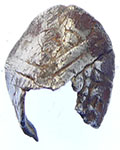 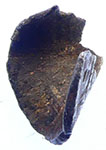 |
||||||
| Roman mount | 1247 Henry III hammered silver voided long cross half penny | ||||||
 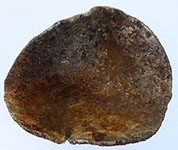 |
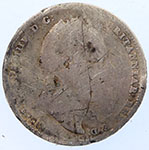  |
||||||
| Victoria milled silver one pence | 1835 William IV milled silver sixpence | ||||||
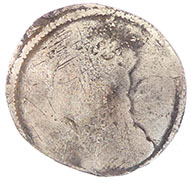  |
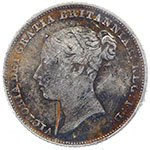  |
||||||
| 1584 Elizabeth 1st hammered silver sixpence | 1839 Victoria milled silver sixpence | ||||||
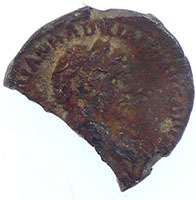 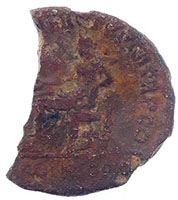 |
 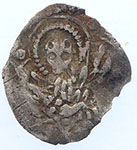 |
||||||
2ndC Roman silver coin - sent for ID That's Hadrian, 117-139 AD. |
Doge Michele Steno (1400-1413).
|
||||||
Beauty 4thC Roman silver coin sent for ID A couple things made (and still make) this hard to pin down - but my best guess is below. My best guess would be: 1.83g, 15.57mm |
|||||||
  |
  |
||||||
| 1533-44 Henry VIII hammered silver half groat - Catherine wheel mint mark | 1844 Victoria milled silver sixpence | ||||||
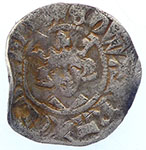 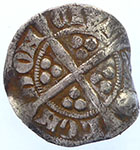 |
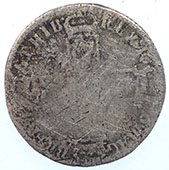  |
||||||
1327 Edward III hammered silver penny Obv +EDWAR R ANGL DNS hYB Rev CIVI/TAS/LON/DON - London mint |
1696 William III milled silver shilling | ||||||
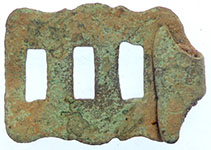 |
 |
  |
|||||
| 18thC clog fastener | Georgian buckle | 1896 Victoria milled silver shilling | |||||
 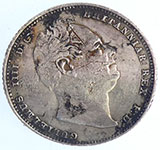 |
 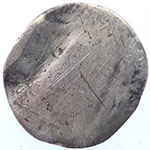 |
||||||
| 1834 William IV milled silver sixpence | 17thC William III milled silver - love token | ||||||
  |
 |
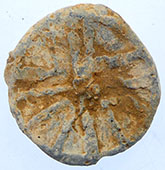 |
|||||
| 1819 George III milled silver sixpence | Georgian buckle | 15thC lead token | |||||
|
|||||||
| Medieval key | |||||||
 |
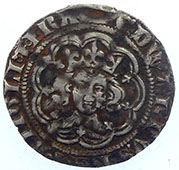 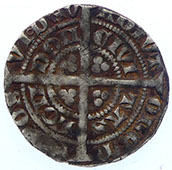 |
||||||
| Georgian jews harp | 1351 - 1353 Edward III hammered silver half groat - Pre treaty series C - annulet stops, no trefoils over crown Obv + EDWARDVS.REX.ANGL.FRANC Rev CIVI/TAS/LON/DON - London mint |
||||||
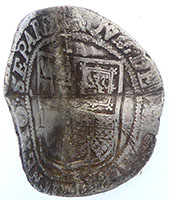 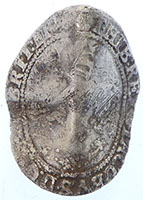 |
 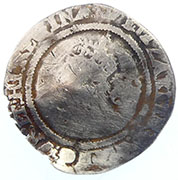 |
||||||
| 1603 James 1st hammered silver shilling - 12 pence | 1568 Elizabeth 1st hammered silver sixpence | ||||||
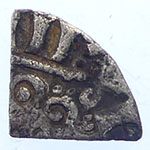 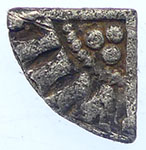 |
  |
||||||
| 1247 Henry III hammered silver voided longcross farthing | 1874 Victoria milled silver three pence | ||||||
 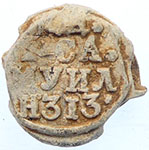 |
 |
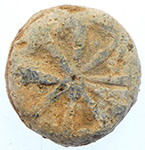 |
|||||
| 18thC lead bale | 15th C lead token | 15th C lead token | |||||
 |
 |
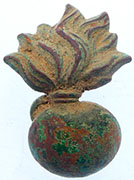 |
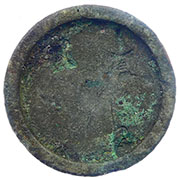 |
||||
| 19thC livery button | 20thC National Express button | Royal fuseliers badge | Georgian trade weight | ||||
 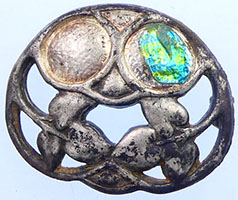 |
|
||||||
1918 Art Deco - Chester silver hallmark brooch - date letter S Maker C.H |
Huge steam whistle ? | ||||||
 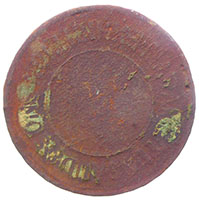 |
 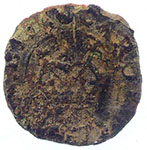 |
||||||
| 19thC London copper trade token | 1634 Charles 1st hammered copper rose farthing | ||||||
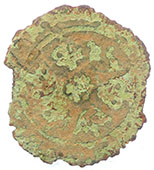 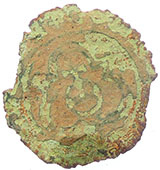 |
  |
||||||
Hans Krauwinckel (1562-1586) Hans Krauwinckel II (1586-1635) Rose Orb German jetton |
1941 George VI milled silver sixpence | ||||||
 |
 |
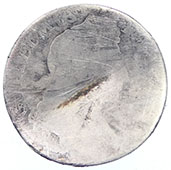  |
|||||
| 19thC livery button | Lead toy | 17thC William III milled silver shilling | |||||
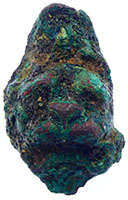  |
 |
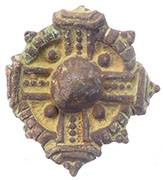 |
|||||
| Georgian lion head bucket mount | Royal Engineers button | 1500-1700 mount | |||||
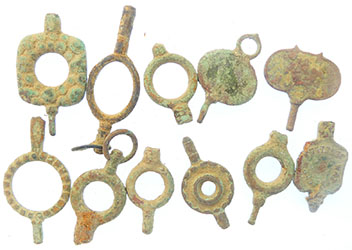 |
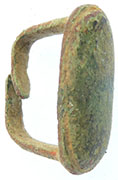 |
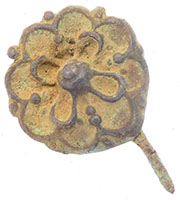 |
|||||
| Georgian watch winders | 17thC belt slide | 1500-1700 mount | |||||
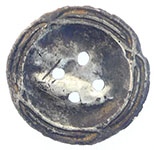 |
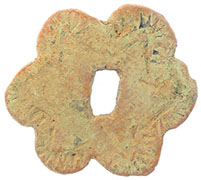 |
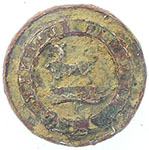 |
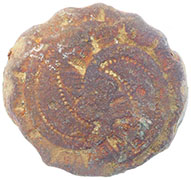 |
||||
| Georgian silver button | Medieval knife quillion | 19thC livery button | |||||
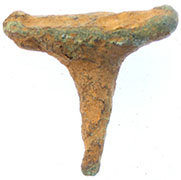 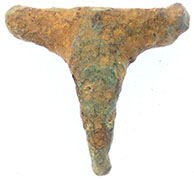 |
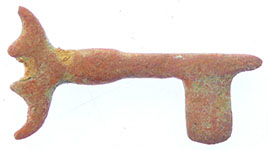 |
 |
|||||
| 2nd Roman fibular brooch | 15thC casket key | 1500-1650 buckle | |||||
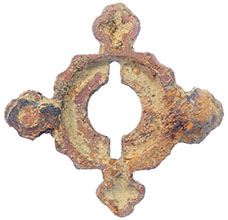 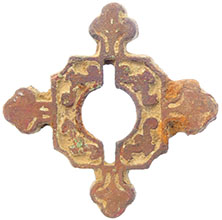 |
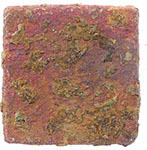  |
||||||
| Post medieval mount | 15thC coin weight | ||||||
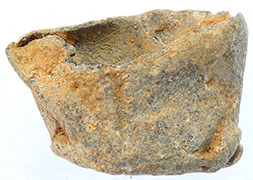  |
 |
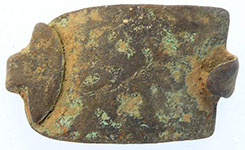 |
|||||
| 1640's Civil War lead gun powder measure and cap | 18thC clog fastener | 18thC clog fastener | |||||
 |
 |
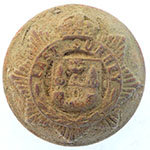 |
 |
||||
| 1500-1700 mount | Unknown Army button | WW1 East Surrey regiment button | Description: 92 within plain inner circle. Category: Regular Army; Type of button: Convex 15mm ; Metal: Copper Alloy silvered; Backmark: EXTRA STRONG PLATED Date: c1820-1840 |
||||
 |
 |
 |
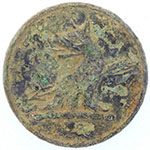 |
||||
| Georgian button | 19thC livery button | Georgian button | 19thC livery button | ||||
  |
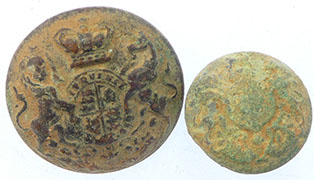 |
||||||
| 16thC Tudor seal spoon handle | General service army button General service buttons had been introduced in the 1870s, when only officers had regimental pattern buttons and other ranks wore the standard design. The buttons continued in service right through from that point onwards and the new khaki service dress introduced in 1902 specified that the buttons should be of the standard GS pattern. A small number of units such as the Guards, Household Cavalry and Rifle regiments had dispensation to wear different buttons, but the vast majority of men used the standard pattern. The buttons themselves feature the royal coat of arms and can be found with both the slightly pointed crown of Queen Victoria and the Imperial crown of Kings Edward VII, George V and George VI |
||||||
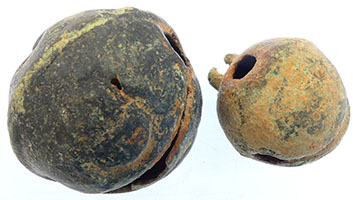 |
 |
 |
|||||
| 18thC crotal bells | Fusiliers lapel badge | 1500-1700 mount | |||||
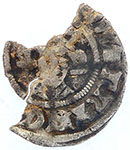 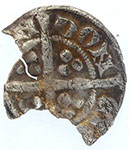 |
  |
||||||
1327 Edward III milled silver sixpence Obv EDWAR R ANG ** Rev N/DON/CI * ** London mint
|
1199 John hammered silver short cross half penny Obv ** VS REX Rev TOMAS - Moneyer Tomas |
||||||
  |
  |
||||||
1217- 1242 Henry III hammered silver short cross half penny Class 7a-7b Obv ** CVS REX Rev **GER OFR.O - Moneyer Roger of R of Canterbury mint |
1929 George V milled silver sixpence | ||||||
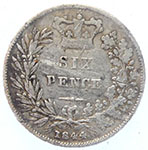  |
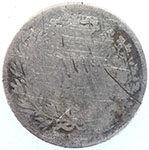  |
||||||
| 1844 Victoria milled silver sixpence | 1834 William IV milled silver sixpence | ||||||
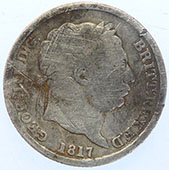  |
 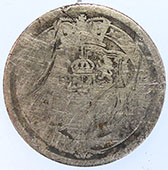 |
||||||
| 1817 George III milled silver shilling | 1820 George III milled silver shilling | ||||||
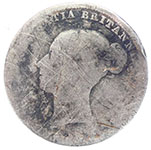  |
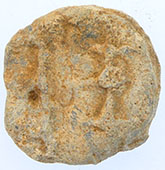 |
 |
|||||
| 19th C Victoria milled silver sixpence | 17thC lead token | 15thC lead token | |||||
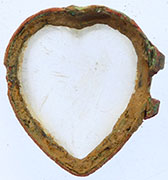  |
 |
 |
|||||
| Georgina glassed faced locket bezel | 18thC sword hanger | Georgian hanress buckle | |||||
 |
 |
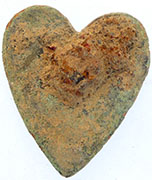 |
 |
||||
| Medieval lead token | Post medieval copper finger ring | 1500-1700 mount | 19thC livery button | ||||
Kiev style Knobbed Mace - c. 12th - 13th century This mace is of a form found across Russia, Ukraine, Moldova, Romania, Hungary, Bulgaria and the former Yugoslavia. Known as the Kirpichnikov Type IV, it originated in Kievan metal foundries and was based on a local adaptation of the Khazar mace type shown above - the Kirpichnikov Type I. The four upper and four lower corners of the Type I’s cube have extended outwards forming smaller knobs giving the Type IV twelve knobs (four large and eight small). These maces were first produced, mostly in bronze, in Kiev and other southern Rus cities. Many existing Kievan bronze examples are highly decorated with rings, lines and dots. Bronze maces were first exported and later copied (in both bronze and iron) throughout much of Europe. Examples are known from the Baltics, Hungary, Romania, Bulgaria, the Western Balkans, Germany, Sweden and England.
These maces are heavy and deadly and would be effective against not only against unarmoured or lightly armoured foes but against any armour of the time (c. 1100-1300). The Turkic peoples of this time usually wore lamellar armour of leather, horn, bronze or iron. This mace is 5.3 cm in diameter and 2.2 cm high. The hole is 17mm in diameter. It has 12 pyramidal knobs in three rows of four - four four-sided knobs and eight three-sided knobs (half knobs). It is hollow cast and is roughly 3mm thick at the edges. The knobs are solid. It is 0.235 kg ). Monster sized chuck of worked bronze - Traces of iron in the hole There is another reference to a knobbed mace found in Hungary below Small Hungarian Knobbed Mace - c. 12th-13th century This small mace head comes from Hungary or its environs. I have found no exact parallel to this style although it is obviously a variation of the Kievan style of knobbed mace head seen above. The bronze construction and high quality imply that it could be an import from the Kiev area. This small mace is 6cm in diameter and 2.9cm high. The hole is 2.6cm in diameter. It has 12 pyramidal knobs in two rows of six. It is hollow cast and is roughly 3mm thick at the edges. The knobs are not hollow. It is only 0.16kg (0.35 lbs). It is made of bronze.
|
|||||||
Massive medieval iron key |
|||||||
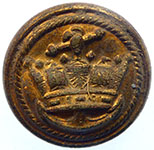 |
 |
 |
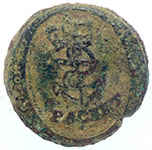 |
||||
| 1900's Generic Merchant Navy Officers | WW1 5th Dragoon Guards lapel badge | RN Capt / Commander - 1901 Kings crown |
RN - Packet Service c.1800-1811 |
||||
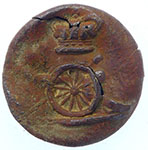 |
 |
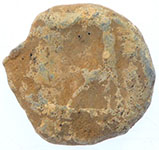 |
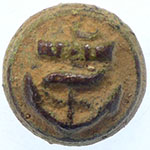 |
||||
| Royal Artillery button Post 1901 -1952 Kings Crown | Interesting gilded eagle mount | 17thC lead token | 1900 Generic merchant navy button | ||||
 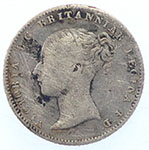 |
 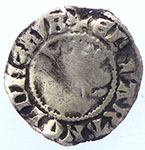 |
||||||
| 1842 Victoria milled silver four pence | 1279 Edward 1st ahmmered silver penny Obv +EDWAR ANGL DNS hYB Rev CIVI/TAS/CAN/TOR - Canterbury mint |
||||||
  |
 |
 |
|||||
| 1818 George III milled silver sixpence | Georgian watch winders | Georgian key | |||||
 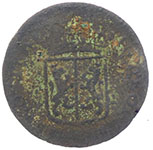 |
 |
 |
|||||
| 1759 Dutch provinces copper coin | 1790-1802 Royal Artillery button | 15thC lead token | |||||
 |
 |
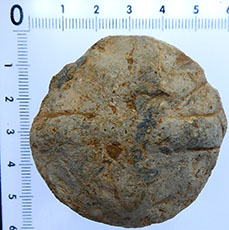  |
|||||
| Capt / Commander - 1774-1787 RN Master & Mate - 1787-1807 RN Surgeon - 1787-1805 |
1500-1700 buckle | Medieval lead long cross trade weight | |||||
  |
 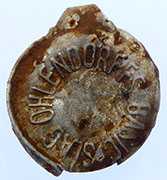 |
||||||
| 19thCVictoria milled silver sixpence | German Ohlendorff & Co Aluminium seal | ||||||
  |
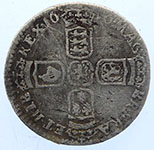 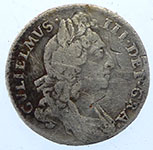 |
||||||
| 1195 - 1230 William 1 The Lion of Scotland hammered silver penny - Short cross and stars issue | 1696 William III milled silver sixpence | ||||||
 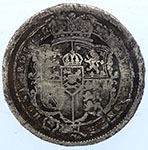 |
 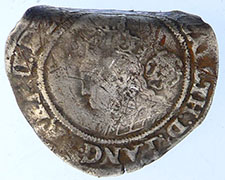 |
||||||
| 1819 George III milled silver sixpence | 1569 Elizabeth 1st hammered silver sixpence | ||||||
  |
 |
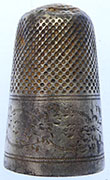 |
|||||
| Georgian pendant with glass stone | Georgian watch winder | Victorian silver thimble | |||||
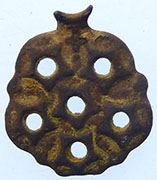 |
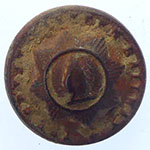 |
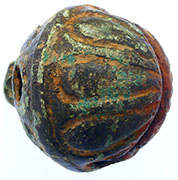 |
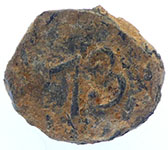 |
||||
| Post medieval pendant | Great Eastern Railways button | 18thC crotal bell | 18thC 73rd Regiment of foot button The 73rd Regiment of Foot was an infantry regiment of the British Army, raised in 1780. Under the Childers Reforms it amalgamated with the 42nd Regiment of Foot to form the Black Watch (Royal Highlanders) in 1881. |
||||
BC Roman silver - sent for ID Yes, it's a (late, probably) Republican AR denarius - or possibly it might fall in the Imperatorial period. |
|||||||
  |
 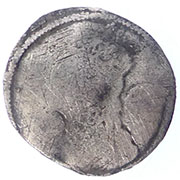 |
||||||
1199 John hammered silver short cross half penny - Class 5c Obv hENRICVS REX Rev **ABEL- Moneyer abel of London mint |
1584 Elizabeth 1st hammered silver sixpence | ||||||
 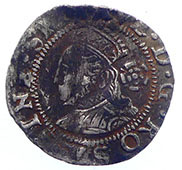 |
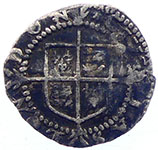 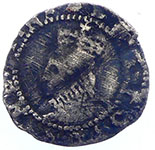 |
||||||
| 1561 Elizabeth 1st hammered silver three pence | 1602 Elizabeth 1st hammered silver penny | ||||||
 |
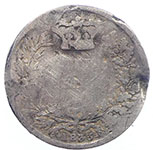  |
||||||
| 18thC toy cannon | 1835 William IV milled silver sixpence | ||||||
 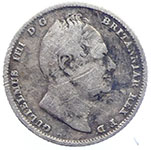 |
 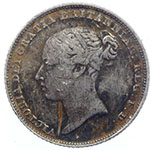 |
||||||
| 1831 William IV milled silver sixpence | 1839 Victoria milled silver sixpence | ||||||
 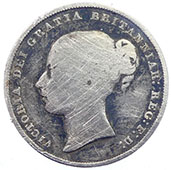 |
 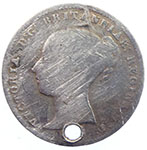 |
||||||
| 1852 Victoria milled silver shilling | 1864 Victoria milled silver three pence | ||||||
 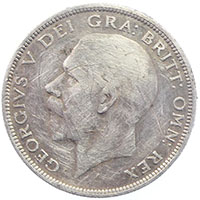 |
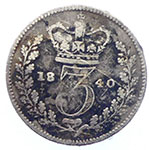  |
||||||
| 1933 George V milled silver half groat (30 pence) | 1840 Victoria milled silver three pence | ||||||
  |
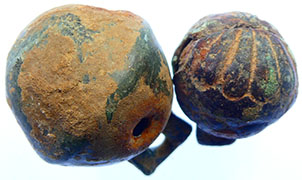 |
||||||
| Victorian gilded silver ring | 18thC crotal bell | ||||||
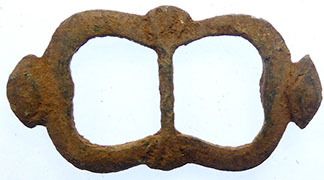 |
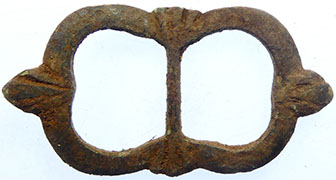 |
||||||
| 1500-1650 buckle | 1500-1650 buckle | ||||||
 |
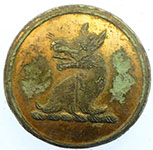 |
 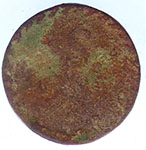 |
|||||
| 1855-1881 - THE 66th REGIMENT OF FOOT. / AFTER 1881 :- 2nd Battalion Princess Charlotte Of Wales's (Royal Berkshire Regiment) | 19thC livery button | 1770 George III gold guinea coin weight - 21 shillings S 21 |
|||||
Interesting early strap divider - researching it |
|||||||
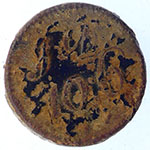  |
  |
||||||
1770 George III gold half guinea coin weight - 10 shillings and 6 pence SD 10 6 |
A scarce original 'Robertson's Golly standard pendant badge', miniature size chromium plated example with curly hair, black bow tie and white waistcoat, the reverse stamped in relief the advertising slogan "Golden Shred". retaining original ring Height with ring 28mm. |
||||||
 |
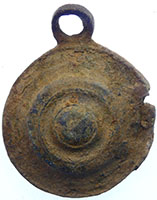 |
 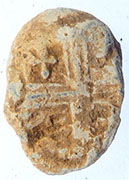 |
|||||
|
1500-1700 pendant | Medieval French lead cloth seal | |||||
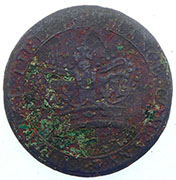 |
 |
 |
|||||
| Corporation company button | 1900's Generic Merchant Navy Officers | 19thC livery button | |||||
 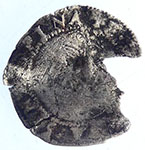 |
 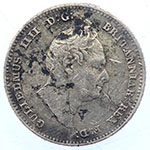 |
||||||
| 1578-9 Elizabeth 1st hammered silver penny- Greek cross mint mark | 1836 William IV milled silver four pence | ||||||
 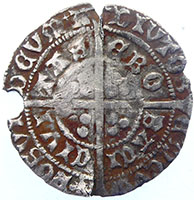 |
|||||||
Very rare Oct 1470- April 1471 Henry VI Restored hammered silver groat - E on neck Obv +hENRI* DI GRA REX ANGL Rev CIVI/TAS/EBO/RACI- York mint |
|||||||
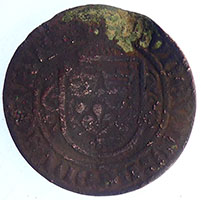 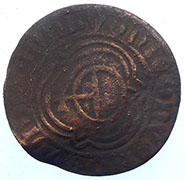 |
  |
||||||
| Unknown Rose Orb Jetton - not in Mitchener Ref book | 1216 Henry III hammered silver short cross farthing | ||||||
  |
  |
||||||
| 1696 William III milled silver sixpence - Bristol mint | 18thC clog fastener | ||||||
 |
 |
||||||
| Georgian watch winders | Castle Gold Foil Saumur Brass Token Medallion W&A Gilbey W & A Gilbey Wine Merchants Brass Medallion Castle Gold Foil Saumur. Walter and Alfred Gilbey founded their wine business in London in 1857. |
||||||
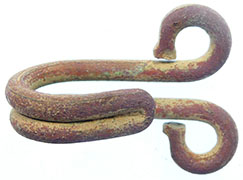 |
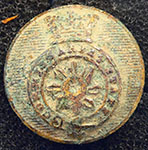 |
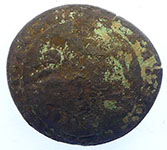 |
|||||
| 17thC clothing fastener | 1830's Victorian Commisssariat staff corp button | Unrecorded 5th Dragoon guards button Description: Crowned Hannover Horse over V D.G with VESTIGIA NULLA RETRORSUM around. Category: Dragoons Type of button: Slightly Convex; Metal: Copper Alloy, silver gilded. Backmark: ; Date: c1780-1796 Crimera war period The 5th Dragoons became Princess Charlotte of Wales's Dragoon Guards in 1804. |
|||||
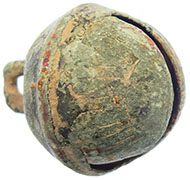 |
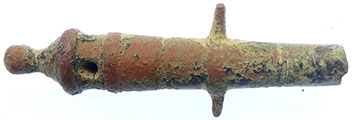 |
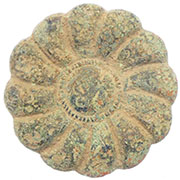 |
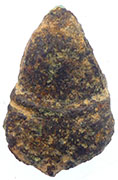 |
||||
| 18thC crotal bell | 18thC toy cannon | 1500-1700 mount | 1500-1700 mount | ||||
 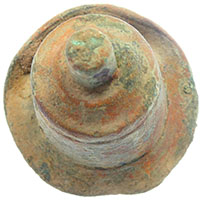 |
 |
 |
|||||
| Georgian horse harness bell | 20thC Navy button | 1873-1901 Royal artillery button | |||||
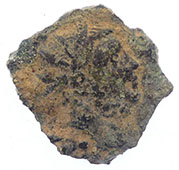  |
 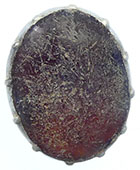 |
||||||
| Mid 4thC Roman barbarous radiate bronze coin | Georgian silver button with red glass stone | ||||||
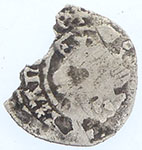 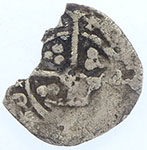 |
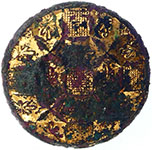 |
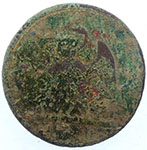 |
|||||
1327 Edward III hammered silver penny - Quadrefoil with pellet at centre of reverse cross - York mint Obv xAN***E +
|
Georgian button | 19thC livery button | |||||
|
 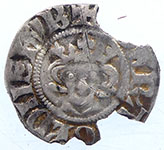 |
||||||
1180-1189 Henry II hammered silver short cross Class 1 Obv **CVS REX Rev + GOCELM - Moneyer Gocelm of Winchester mint |
1327 Edward III hammered silver penny Obv + *** WRA **GL'DNS hYB Rev CIVI/TAS/LON/DON |
||||||
 |
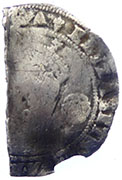 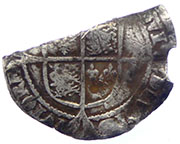 |
||||||
| 19thC crotal bell | 1573-1574 Elizabeth 1st hammered silver sixpence - acorn mintmark | ||||||
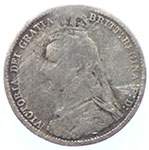  |
 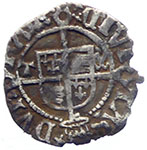 |
||||||
| 1892 Victoria milled silver sxipence | 1530 Henry VIII hammered silver sovereign penny TW by shield- Archbishop Wosley |
||||||
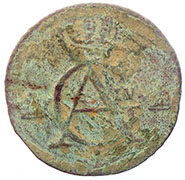 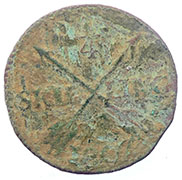 |
 |
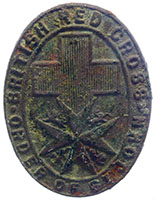 |
|||||
| 1802 Sweden Gustaf Adolf IV 1/4 skilling copper coin | Victorian customs button | WWI Order of St John British Red Cross badge | |||||
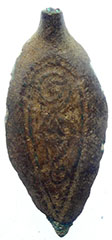 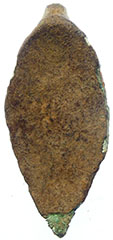 |
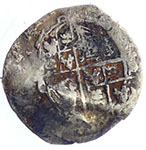 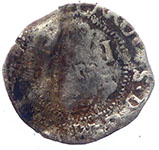 |
||||||
| Roman bronze mount | 1625 Charles 1st hammered silver penny | ||||||
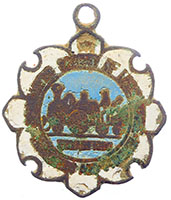 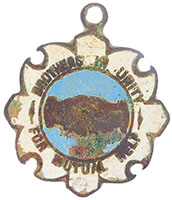 |
  |
||||||
| Pre 1940 Aslef Brothers In Unity Mutual Help Railway Trade Union Enamel Fob Badge
Associated Society of Locomotive Engineers and Firemen Brothers in unity for mutual help |
19thC George III milled silver sixpence | ||||||
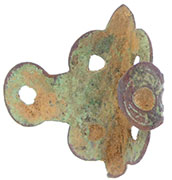 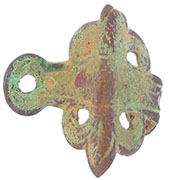 |
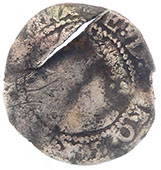  |
||||||
| Medieval clasp | 1592 -5 Elizabeth 1st hammered silver half groat - Tun mint mark | ||||||
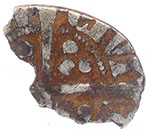 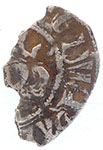 |
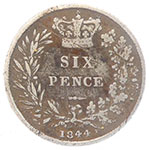 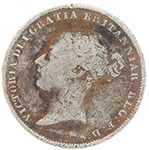 |
||||||
1274 Edward 1st hammered silver penny Obc EDWR |
1844 Victoria milled silver sixpence | ||||||
 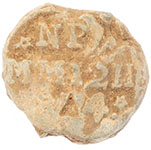 |
  |
||||||
| 1860 Russian lead bale seal | 1165-1214 William the Lion - Scottish hammered silver half penny - struck in name of William Short cross and stars issue Obv WILELMUS RE Rev AILBODE - Moneyer Ailbode
|
||||||
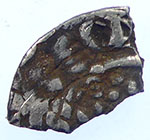 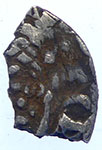 |
 |
 |
|||||
| Medieval hammered silver coin fragment | 15thC lead token | 16thC clothing fastener | |||||
 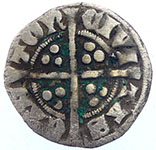 |
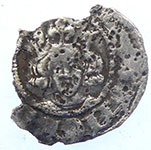  |
||||||
1279 Edward 1st hammered silver penny Obv EDWAR ANGL DNS hYB Rev CIVI/TAS/CAN/TOR - Canterbury mint |
1279 Edward 1st hammered silver penny Obv ANGL *** Rev LON/CIVI/** London mint |
||||||
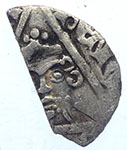  |
 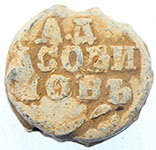 |
||||||
Irish 1216-1272 Henry III hammered silver voided long cross half penny Obv hEN ** Rev DAV- Moneyer Davi |
1830 Russian lead bale seal | ||||||
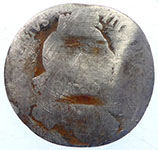 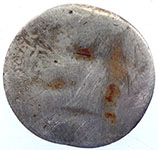 |
 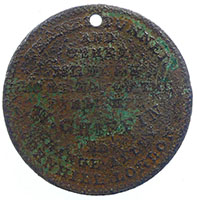 |
||||||
| 17thC William III milled silver sixpence | 1843 Thames Tunnel medallion |
||||||
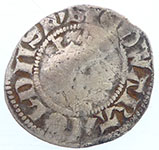 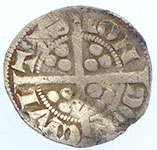 |
 |
||||||
1279 Edward 1st hammered silver penny Obv + EDWAR ANGLE ANGL DNS hYB Rev CIVI/TAS/LON/DON- London mint |
Description: 'DM' surmounted by earls coronet with incised line around edge Category:English Infantry Militia; Type of button: Flat 25mm; Metal: Copper Alloy, silvered .; Backmark:None ; Date: 1759-c1800 Notes: The Durham Militia was founded in 1759, becoming the 1st Durham Militia in 1853 and in 1881 making up the 3rd battalion of the Durham Light Infantry. This first style of button shows the earls coronet that relates to the 2nd and 3rd Earls of Darlington who were successively colonels of the regiment. |
||||||
Early 1st Century BC into 1st Century AD Roman brooch Facinating fibular brooch - similar to Greek type or La Tene III |
|||||||
  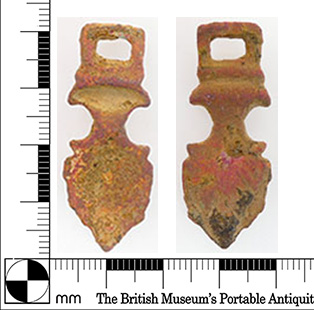 |
|||||||
Roman strap suspension - 41.77mm L x 15.08mm W x 3.2mm thick 5g |
|||||||
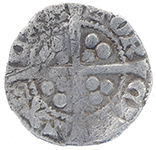 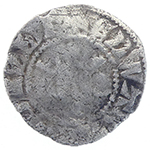 |
 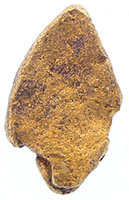 |
||||||
1279 Edward 1st hammered silver penny Obv +EDWAR ANGL DNS hYB Rev CIVI/TAS/CAN/TOR- Canterbury mint |
Illegible gold coin fragment - possible Celtic qtr stater 0.58g, 11.9mm L x 1.62mm T |
||||||
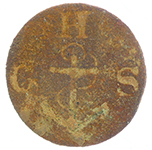 |
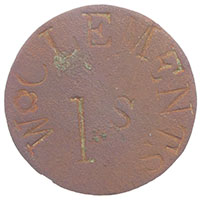 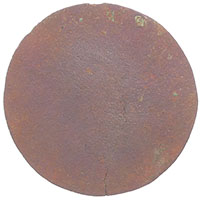 |
||||||
| RN Greenwich Hospital Service Officer's Hospital Staff Tunic Button In use 1800 - 1815 |
Victorian W. Clements - 1 shilling token | ||||||
Unknown small implement - possible ear wax scraper - researching it |
|||||||
 |
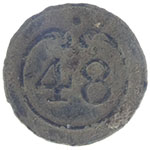 |
  |
|||||
| Medieval sexfoil mount | French Infantry Button 48th Line Regiment Circa 1803-1814 |
1856 -Germany Prussiaa 3 Pfenning copper coin | |||||
  |
 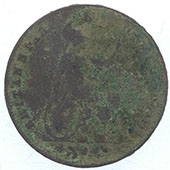 |
||||||
| 1787 Dutch copper coin - Utrech | 1837 William IV milled copper half penny | ||||||
  |
 |
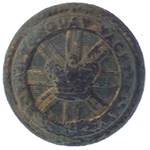 |
|||||
| 1216 Henry III hammered silver short cross half penny | 18thC Royal Navy button | 1863 Royal Torbay yacht club button | |||||
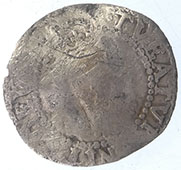 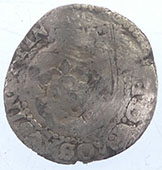 |
|||||||
| 1603 James 1st hammered silver half groat | |||||||
Canadian Bill has made a great ID on this badge we found
United States Army Army Warrant Officer Branch Insignia - Officer Gold U.S. Army Branch Insignia Badges represent a service member's specific field of service. Each soldier - both enlisted and officer - wear their branch insignia badge on their Class A or Army dress blue uniforms denoting their particular skill set. Army branch insignia badges differ from Army qualification badges. Qualification badges require completion of a training course or school, while branch insignia badges are issued to a service member upon being assigned to a particular area of the Army. Enlisted soldiers wear the branch insignia on the left coat lapel, opposite the "U.S." insignia disk, whereas, officers wear the insignia on the lower half of both lapels beneath the "U.S." insignia. Branch insignia were first worn prior to the Civil War in the 1850s by Army personnel. |
|||||||
Roman bronze mount |
|||||||
2023 March finds page |
|||||||
 |
|||||||

